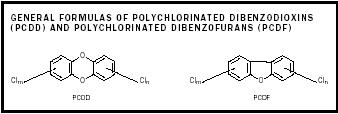Dioxin
Dioxin, formed by burning chlorine-based chemical compounds with hydrocarbons, is one of the most toxic chemicals known. Dioxin is a general term

Dioxin has become the synonym for polychlorinated dibenzo[1,4]dioxins (PCDD) in general or the most toxic congener 2,3,7,8-tetrachloro dibenzo[1,4]dioxin (TCDD) in particular. PCDD comprise a group of seventy-five structurally similar compounds, so-called congeners. The individual congeners differ in the number and positions of the chlorine atoms in the molecule. Structurally related are the polychlorinated dibenzofurans (PCDF) (135 congeners). PCDD and PCDF are stable and fat-soluble molecules classified as persistent organic pollutants (POPs). The central element of the PCDD is the dioxin 6-ring, containing two oxygen atoms, while in PCDF it is the furan 5-ring, containing one oxygen atom. Apart from the structural similarity, they are often formed in the same processes, such as combustion.
PCDD and PCDF are formed incidentally in combustion and chemical production processes. Combustion processes include municipal and backyard waste incineration, residential and industrial burning of wood and coal, internal combustion in vehicle engines, and forest fires. Prerequisites for PCDD and PCDF formation are the presence of carbon compounds and inorganic or organic chlorine sources (e.g., sodium chloride or polyvinyl chloride). Their creation generally requires temperatures around 300°C and an excess or lack of oxygen. PCDD and PCDF are present as impurities in a variety of chemical products.
Chlorophenol-based pesticides like 2,4,5-T, a phenoxy herbicide, were responsible for up to half the environmental emissions of PCDD and PCDF in the early 1970s. A 1:1 mixture of 2,4-D and 2,4,5-T was used in Agent Orange; it contained elevated levels of PCDD. An estimated 110 to 170 kilograms (kg) of 2,3,7,8-TCDD alone were sprayed with herbicides over Vietnam. Consequently, acute and chronic health effects were observed in the exposed population and military personnel. Further examples of PCDD-contaminated chemical products are the wood, leather, and textile preservative pentachlorophenol, the widely used antimicrobial triclosan, and PCDF in polychlorinated biphenyls (PCBs). Certain thermal metallurgical processes as well as chlorine-based pulp and paper bleaching emit PCDD and PCDF into the environment. In its 1995 inventory, the U.S. Environmental Protection Agency (EPA) identified municipal and medical waste incineration, backyard refuse barrel burning, secondary copper smelting, and cement kilns burning hazardous waste as the largest current sources of dioxin-like compounds.

It has been claimed that 2,3,7,8-TCDD is the most toxic human-made compound, an ultra-poison. Although some evidence supports this view, the results of many studies are still controversial. 2,3,7,8-TCDD is extremely toxic to guinea pigs (the lethal dose is approximately 1 microgram or μg). For other animals and apparently for humans the acute toxicity is considerably lower. Long-term effects appear to be more serious. 2,3,7,8-TCDD was found to be the most potent multisite carcinogen in test animals, and PCDD and PCDF are also a human carcinogen. Noncancer effects may pose an even greater threat to human health. These include effects on reproduction and sexual development, teratogenic effects, endocrine disruption, suppression of the immune system, and neurological effects. PCDD and PCDF bioaccumulate and are stored in the body fat of higher organisms. About 95 percent of human exposure originates from food, especially fish, meat, eggs, and dairy products.
A 1990 global emission inventory estimated that municipal waste incineration was the major source of PCDD and PCDF in the environment. Abatement strategies focus on this issue. State-of-the-art incinerators may act as sinks for dioxins, but they are expensive to construct and operate. At a higher cost-efficiency, PCDD and PCDF reduction could be achieved by a reduction in the amount of garbage to be destroyed (e.g., by manufacturing long-lived products and using less packaging), a cessation of open waste burning, and technical improvements in as of yet less strictly regulated facilities such as cement kilns and metallurgical industries.
The remediation of dioxin-contaminated sites requires sophisticated abatement methods. Cleaning the Times Beach Superfund site was a ten-year effort that included the relocation of its inhabitants, construction of a series of spur levees surrounding the site to prevent floodwater from carrying contaminated soil off-site, installing a temporary incinerator, and the excavation and burning of 265,000 tons of contaminated soil.
SEE ALSO B URN B ARRELS ; C ANCER ; E NDOCRINE D ISRUPTION ; H EALTH , H UMAN ; I NCINERATION ; M EDICAL W ASTE ; P ERSISTENT O RGANIC P OLLUTANTS (POPs) ; S UPERFUND ; T IMES B EACH , M ISSOURI ; W AR .
Bibliography
IARC Working Group on the Evaluation of Carcinogenic Risks to Humans. (1997). Polychlorinated Dibenzo-para-dioxins and Polychlorinated Dibenzofurans. Lyon, France: World Health Organization, International Agency for Research on Cancer.
Safe, Stephen; Hutzinger, Otto; and Hill, T.A., eds. (1990). Polychlorinated Dibenzo-pdioxins and -furans (PCDDs/PCDFs): Sources and Environmental Impact, Epidemiology, Mechanisms of Action, Health Risks. New York: Springer-Verlag.
Young, Alvin L., and Reggiani, G.M., eds. (1988). Agent Orange and Its Associated Dioxin: Assessment of a Controversy. New York: Elsevier.
Internet Resource
Activists' Center for Training in Organizing and Networking (ACTION). Available from http://www.ejnet.org/dioxin .
Stefan Weigel
Comment about this article, ask questions, or add new information about this topic: